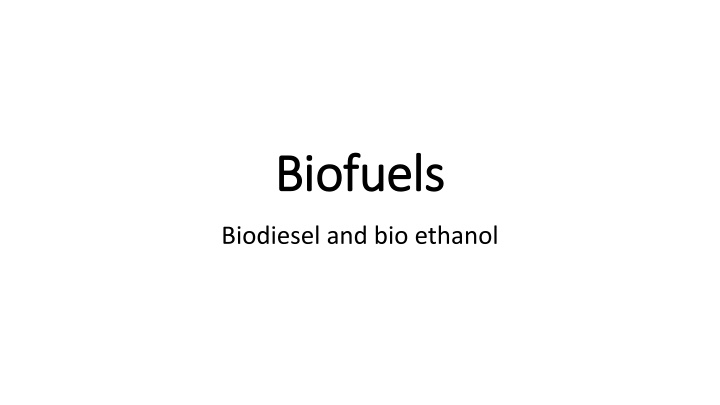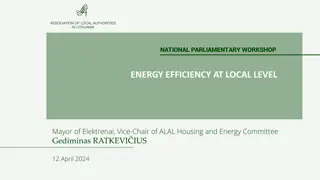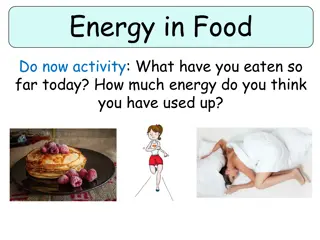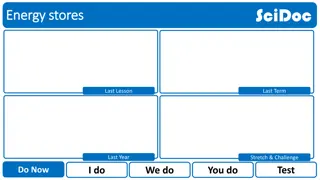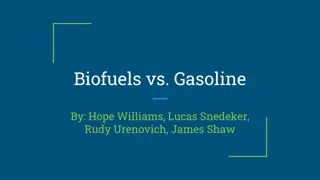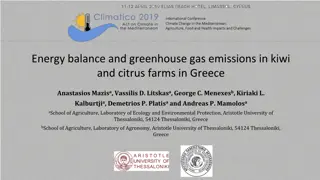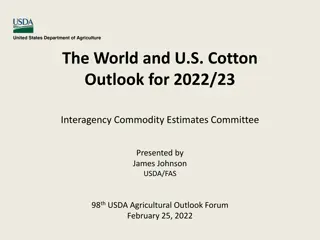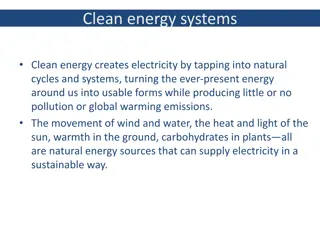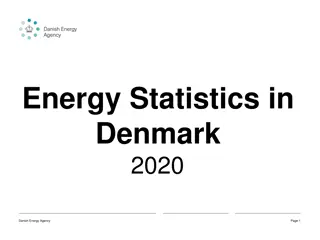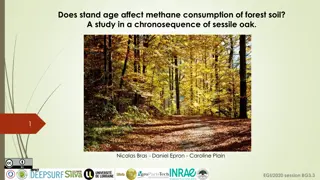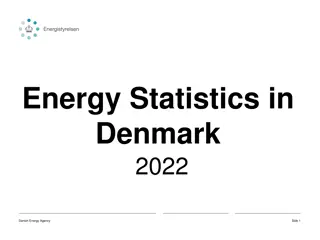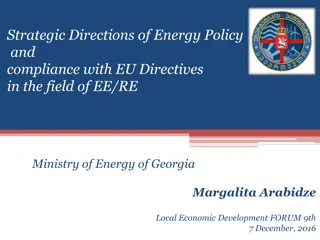Overview of Biofuels and Global Energy Consumption
Learn about biofuels like biodiesel and bioethanol, their impact on global warming, different energy sources, and the rising CO2 levels. Explore the role of fossil fuels, political goals, and environmental effects.
Download Presentation

Please find below an Image/Link to download the presentation.
The content on the website is provided AS IS for your information and personal use only. It may not be sold, licensed, or shared on other websites without obtaining consent from the author.If you encounter any issues during the download, it is possible that the publisher has removed the file from their server.
You are allowed to download the files provided on this website for personal or commercial use, subject to the condition that they are used lawfully. All files are the property of their respective owners.
The content on the website is provided AS IS for your information and personal use only. It may not be sold, licensed, or shared on other websites without obtaining consent from the author.
E N D
Presentation Transcript
Biofuels Biofuels Biodiesel and bio ethanol
Energy consumption and global warming
Exercise in groups For what purposes do we use energy? Which energy sources do you know ?
Energy consumption in XX To the teacher: Please add statistic showing energy consumption by source for your own country
Atmospheric CO2-levels are rising Carbondioxide concentration from 1700 till now Carbondioxide concentration from 1958 till now
U.S. Environmental Protection Agency Greenhouse effect and global warming The Greenhouse Effect (Youtube video)
Political goals The increased amount of CO2in the atmosphere contribute to the greenhouse effect/global warming . EU climate policy has the following main objectives reduction of greenhouse gases use of renewable energy increased energy efficiency . In this context agriculture can play a part by growing crops that are wholly or partly used to produce energy .
Fossil fuels FOSSIL FUELS originate from organisms that lived millions of years ago. Examples of fossil fuels: coal, oil , natural gas,
Biofuels BIOFUELS originate from organisms that lived recently. Examples of biofuels: wood, straw , biodiesel, bioethanol , biogas Biodiesel
Energi, vand og CO2 Energi, vand og CO2 CO2is developed- whether you burn biofuels or fossil fuels . The difference is ...
Fossil fuels are not CO2-neutral CO2 When you burn fossil fuels the atmospheric concentration of CO2 rises
Biofuels are CO2-neutral CO2 When wood - or another biofuel is burned, the CO2concentration will not rise. CO2is developed but only the same amount that the trees (plants) have used in photosynthesis while growing.
Some biofuels Fuel type Source Kan replace/supplement Biodiesel Vegetable oils and animal fats Diesel Bio ethanol Grain, corn, grasses, straw, can , willow, residual wood (carbohydrate part ) Gasoline Biogas Manure, straw, fat waste, grasses, whey (org . waste) Natural gas
Vegetable oil directly in your diesel engine? No Mineral diesel consists of long carbohydrate molecules which results in a liquid as thin as water. Vegetable oils consist of triglyceride molecules.
Basic biodiesel chemistry The triglycerides of a vegetable oil consist of a glycerol backbone and 3 fatty acids. When you mix the vegetable oil well with methanol and potassium hydroxide you get biodiesel and glycerol. The potassium hydroxide is the catalyst (= makes the reaction happen but is not consumed).
Production of biodiesel the short version Fat Methanol Biodiesel
What kinds of fats can be used? For instance Animal fat (abattoir) Used frying oil Rapeseed oil Discuss the use of these different types of fat
To the teacher: Here you might introduce the biodiesel experiment
How to make ethanol Alcohol Sugar Fermentation (ethanol) Alcohol/ethanol can be made by fermentation of sugar. The starting material need not be pure sucrose, but may be biomass/plant material which is rich in carbohydrate. Before the fermentation can take place some preliminary steps are necessary, however
Basic carbohydrate chemistry To the teacher: The following slides give only a brief overview of carbohydrate structure. In stead of showing the slides you could ask the students to find information about mono-, di- and polysaccharides themselves. Types, structure, where do we find the different types etc.
Carbohydrates Carbohydrates are built up of carbon, hydrogen and oxygen. Carbohydrates contain energy. Carbohydrates are divided into Monosaccharides Disaccharides Polysaccharides
Monosakkarider er simple kulhydrater An example of a simple carbohydrate is dextrose (glucose) , which is the sugar made in photosynthesis. In a dextrose molecule the atoms are organized in ring in the shape of a hexagon. Another example is fruit sugar (fructose) which has the shape of a pentagon. Mono means one and implies that they only have one sugar ring .
Disakkarider The simple monosaccharides can serve as building blocks. By putting together two monosaccharides you get a disaccharide ( di means two). Sucrose (plain sugar) is made of one glucose and one fructose molecule. Maltose is made of two glucose molecules.
Starch a polysaccharide Polysaccharides er made by many monosaccharides put together ( poly means many). . . . . . . . Starch is one example of a polysaccharide, that is made by long chains of dextrose.
Cellulose another polysaccharide Another example of a polysaccharide which is composed of glucose chains is cellulose, which is found in plant cell walls. . . . . . . . The bonds between the dextrose molecules in cellulose are not so easy to break as in starch. This difference also is important in the production of bioethanol.
Structural formulas On this website you can find more structural formulas for monosaccharides, disaccharides and polysaccarides (including the difference between starch and cellulosis)
Production of bio ethanol Alcohol Sugar Fermentation (ethanol) Alcohol Biomass Sugar Pre-treatment Fermentation (ethanol) During pre-treatment the polysaccharides are cut into monosaccharides before fermentation. The pre-treatment needed depends of the type of biomass used.
1. generation bio ethanol The raw material can be sugar cane and sugar beet (containing carbohydrate in the form of sugar), maize or cereal (containing carbohydrate in the form of starch). Alcohol Biomass Sugar Light pre-treatment Fermentation (ethanol) This requires only a light pretreatment because starch can be broken down .
2. generation bio ethanol The raw material can be straw, corn stalks, wood (contains carbohydrates in the form of lignocellulose ) These plants contain carbohydrates that are difficult to extract and convert into ethanol = energy intensive pretreatment. Alcohol Energy intensiv pre- treatment Biomass Sugar Fermentation (ethanol) Benefits: The method uses waste material, which is cheap and present in large amounts.
IBUS-plant a second generation plant using straw Pretreatment of straw : Chopping (1-5 cm long pieces ) Soaking in water Heating the " straw soup" at high pressure ( 190-200 C , 13-18 bar) for 10-15 minutes The carbohydrates in the heated " straw soup" are degraded by a number of enzymes added to the sugar
IBUS-plant fermentation and waste After pre-treatment , the sugar is ready to be converted to ethanol using yeast. After fermentation, filtration and distillation you have pure ethanol. The residual from the production is solid biofuel and liquid molasses: The biofuel is used as an energy source for the pre-treatment and distillation. The molasses can be used as animal feed.
